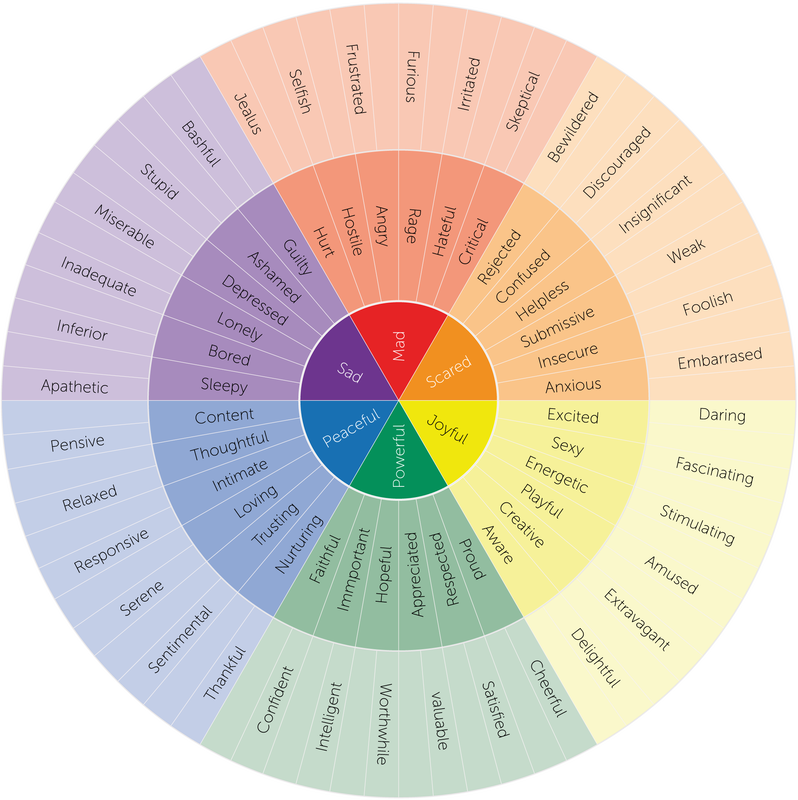 My own battle with depression began in high school and really escalated when I went to college. My entire first year of college was nearly consumed by depression. I had crippling self-doubt, negative thoughts and chaotic relationships. Finding a therapist really helped on that journey but still I did not feel any real improvement until one day I noticed a cherry tree in bloom. It was in that moment that I realized that I had not even looked up in almost a year. I walked through every day just staring at my feet, but in that moment I saw some beautiful, something outside of myself and I realized that I had hope for a life free from depression. Now I have that life but it doesn't mean that I am happy all of the time and I do have real struggles. What I learned about depression is that it makes everything hard: going to work, relationships, hobbies and sometimes just existing is hard. One of the symptoms of depression is that you no longer enjoy the things that you used to. Sometimes, one of the best skills you can use when you are depressed is pushing yourself to do the things that you used to enjoy and maybe one day you will find yourself looking up and noticing a real change.
0 Comments
 Have you ever looked at an old picture of yourself and thought wow, I was thinner and younger and I still don't remember being happy? Happiness is a funny thing. Sometimes we look for reasons not to be happy. When we accomplish our goals we move right on to the next goal without a lot of happiness. In the last 20 years, there has been a lot of research on happiness and there are some things we can do to experience more happiness in our lives. About half of happiness is actually based on your genes and is out of your control. The funny thing is that very little of happiness actually has to do with your situation. For the most part, people experience great and terrible things with appropriate emotional responses but they tend to come back to our baseline quickly. As a therapist, the number one goal I hear from clients is that they want to be happy. More often than not, this happiness has something to do with money. Does money bring happiness? The answer is that some money does bring happiness when it buys security and basic needs. However, more money like mansions and fancy cars do not tend to bring happiness. Here are some tips to help you recognize and embrace your happiness. Try these 4 tips for feeling happier and see if your perspective changes. Concentrate on helping others or the world around you Helping others and being concerned with their wellbeing has been proven to make you a happier person. Try to help someone else at least once a week. Keep a gratitude list Being grateful for what you have can shift your perspective. Try keeping a gratitude journal and review it at least once a week. Try new things Your brain responds better to novel experiences so try to vary your routine a little. Walk or drive a different way and challenge yourself with new experiences. Lower your expectations Sometimes our expectations are too high and they make feeling happy difficult. Lowering your expectations can help you experience more happiness. However, this is not the same as feeling hopeless or not setting goals.  It seems like compromise is never the first thing we think of when we are in an argument. When people realize they have disagreements it is tempting to amplify or hyperfocus on those differences. So many of my clients come to work on issues that constitute a small fraction of the relationship in question. Couples will spend an hour talking about disagreements without acknowledging all of the issues that they agree on. Sometimes, it is good to remember what is going well. Compromise happens when couples build bridges and think outside of the box for possible solutions. Very few problems have only one or even two solutions. One of the best skills to help you reach a compromise is to listen to what your partner is saying and start talking about the issues you agree with. This can help you both be on the same side of the table and not engaged in a chess match. It may be possible for both people to get what they want. However, with any compromise, you may not get everything you are asking for. Sometimes it is a good idea to ask yourself "is this the hill I want to die on" and be able to move on if it isn't. Remember, you are working with your partner to solve problems. Your partner is not the problem you are solving.  Some people can look at the world and themselves through rose colored glasses. They can see the best in everything, even when life gets hard. Others see the world through lens of their own in ways that put a gloomy view on everything they see. What if you could change your lenses and see the world in a new way? The psychological term for these lenses is core beliefs. They are hidden beliefs we have about ourselves, others and the world around us. Having negative core beliefs may contribute to depression or anxiety, especially if you view yourself as negative and are wary or afraid of the world itself. These core beliefs can make it difficult to cultivate self-esteem, trust other people or feel safe in your environment. So when it really comes down to it, what do you think of yourself. Take a blank piece of paper and write the words "I AM ________" and make a list of as many words as you can without spending too much thought on it. This will help you identify negative core beliefs. As a therapist, I hear a lot of core beliefs in my conversation with clients and the one I hear the most is "I am unloveable" or "they wouldn't love me if they knew what I have done". This core belief erodes self-esteem, increases shame and guarantees future secrets. This core belief can change when someone loves you anyway, despite the things you may have done and despite the negative things you think about yourself. Most people have a combination of positive and negative core beliefs. One of the best ways to challenge negative core beliefs is to ask yourself if you have evidence for your beliefs or are they based on feelings. Remember, feelings are important parts of your inner experience but feelings are not facts.  In general, there are four types of communication. On one extreme there is passive communication. Passive people may sit quietly and even nod when they disagree with what is being said. Passive communicators generally do not get their needs met. The opposite extreme is aggressive communication, which may include swearing, aggressive body language (getting in someone's face) and could escalate to physical violence. Aggressive communicators are use to getting what they want through bullying others. Sometimes it is possible for someone to both passive and aggressive at the same time. This is called passive-aggressive. The communicators may agree with you to your face but gossip about you later. Passive-aggressive communication is the most difficult form of communication to deal with. Finally, in between passive and aggressive on the spectrum of communication there is assertive. Assertive people manage to get their own needs met while respecting the boundaries and autonomy of others. Assertiveness is the only recommended form of communication but it can be hard to get quite right when you first start practicing. The first tip for assertiveness is to use "I statements". These statements make communication less accusatory and can be more easily heard by others. The second tip is to focus on your feelings because feelings can never wrong. Unlike facts, they cannot be argued with. They exist in your experience and expressing them can help take weight of your shoulders but also help others understand you and your perspective. The best question to ask yourself about your communication style is whether or not it is effective. Most people resort to name calling, swearing and aggressive gesturing in order to be heard, but it actually has the opposite effect. People stop listening when they feel threatened. Most communication is actually body language, which makes your overall demeanor very important. Tone of voice is also important. The actual words you use represent less than 10% of overall communication. This is why it is so easy to miscommunicate in texts and emails. The number one way to make sure you are heard by others is to listen to them.
THE LOVE MAPS 20 QUESTIONS GAME Now that you understand the importance of building Love Maps and have assessed the quality of you and your partner’s current Love Maps, play a fun, light-hearted game with your partner. The more you play, the more you’ll learn about the Love Maps concept and how to apply it to your relationship. Each of you should ask your partner the questions below. If your spouse answers correctly (you be the judge), he or she receives a point. If your partner responds incorrectly, neither of you receives any points. The same rules apply when you answer. The winner is the person with the higher score after you’ve both answer all twenty questions. Questions: 1. Name two of my closest friends 2. What is my favorite musical group, composer, or instrument? 3. What was I wearing when we first met? 4. Name one of my hobbies. 5. Where was I born? 6. What stresses am I facing right now? 7. Describe in detail what I did today, or yesterday. 8. When is my birthday? 9. What is the date of our anniversary? 10. Who is my favorite relative? 11. What is my fondest unrealized dream? 12. What is my favorite website? 13. What is one of my greatest fears or disaster scenarios? 14. What kind of present would I like best? 15. What makes me feel most competent? 16. What was my favorite vacation? 17. What is my favorite meal? 18. What is my favorite way to spend an evening? 19. What is my favorite color? 20. What personal improvements do I want to the least? * From Gottman
 “Hope is being able to see that there is light despite all of the darkness.” – Desmond Tutu Hope is the belief that things will be better than they are right now. This could be a belief that you will be less depressed, free from porn or that your relationship will improve. Hope is vital to making any real progress in therapy. As a therapist, I hold hope for people who cannot do it for themselves. The lack of hope is soul crushing and it can steal your joy or drive you to end it all. I encourage clients to begin each session by answering the question "what's better this week?" It is so easy to focus on the problem, after all, the problem is why people come to therapy. Things get better a little at a time and sometimes it takes work to really notice a change. Statistically, clients make some of their best progress in treatment before they ever meet the therapist. This is because they have newfound hope that things will be better tomorrow than they are today. So where ever you are in your journey, look to the progress you have already made and try to build on it and when you find yourself with no hope then look to a friend, a family member or a therapist to hold that hope for you until you can see it for yourself.
 Setting intentions is a concept used often in therapy and in meditation. By focusing on your preferred intention you can roll the ball in the right direction and this can really help you survive the moment and take a step toward being the person you have always wanted to be. To do this, you simply need to complete the sentence I INTEND TO _________. Intentions should be positive and exist in the moment. Something you plan to do or even be today or this week. The best way to use intentions is to incorporate them into what you are already doing. This could be journaling, prayer, meditation and mindfulness. One of the most useful outcomes in using intentions is that you are finally aware of these positive qualities that are already in your life and you can move toward expanding them. The best intentions are specific to you and may take some thought and practice to use. In the mean time, here are some intentions that have helped other clients:
 For many people struggling with depression and bipolar disorder it can be difficult to know if things are getting better or worse. We all have bad days and it is easy to have a bad day and think that depression is getting worse. However, the best way to know if your symptoms are worsening is to keep a mood journal. This can be as simple as keeping a written record of your mood each day. Most mood trackers or journals also document triggers or things that happen that make us feel a certain way. They can also track changes in medication, exercise and substance use. One of the biggest problems with being depressed for long periods of time is that you can lose your baseline. This means that you no longer realize the magnitude of your depression. Keeping a mood journal can help you analyze trends in your mood and better understand the severity of your illness. Mood journals come in many forms and may favorite type of journal is an app. The app Mood Notes gives people the ability to track daily mood and circumstances as well as well as analyzing faulty thinking that may be worsening your mood. Another great mood app is called Dailyo and is similar to Mood Notes. Reviews for both Mood Notes and Dailyo are included at the end of this blog post. Some people still prefer to use pencil and paper when it comes to tracking mood. Here is a mood chart that I recommend for clients.
|
||||||||||||

